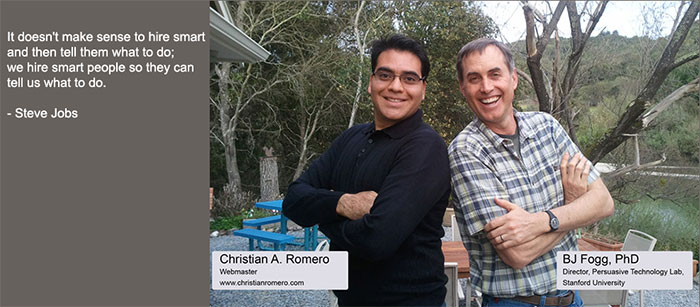For 20 years, I have been developing software for small businesses and large corporations. I knew something was missing to make systems more successful at the beginning. Many ventures apply the benefits factor to their equation, and I came to the conclusion that this approach is good but not the best approach.
This is when I discovered behavior design. Proof has shown that the dozens of large companies that have applied behavior design from their inception have set themselves up for a higher rate of success, sometimes leading them to be sold for billions and even millions of dollars. Instagram and students from Stanford creating Facebook apps have proven the concept.
I was part of a special group receiving training from Dr. BJ Fogg of Stanford University, the inventor of behavior design. He is a guru in innovative web businesses and behavior design, or the study of how technology influences human behavior. His goal was for our special group to become masters in behavior design, and I’m pleased that his goal was met.
Unlocking Exponential Growth Through Behavior Design: From Small Business to Billion-Dollar Results
In my professional journey—spanning from consulting with small business owners to collaborating with executives at Fortune 500 companies—I’ve consistently observed one fundamental truth: a strong online presence is essential, but it’s not enough. Real, scalable growth only occurs when that presence is engineered around human behavior.
It wasn’t until I integrated the principles of Behavior Design, developed by Dr. BJ Fogg of Stanford University, that I began to see truly exponential results—both for the ventures I support and in my own strategic advisory roles.
What Is Behavior Design?
Behavior Design is a system for influencing human actions by shaping the environment, timing, and triggers that lead people to act.
When all three align, behavior change becomes not only possible—but predictable.
The Stanford Case Study: From $300 Million to $1.2 Billion
One of the most compelling examples of Behavior Design in action is from Stanford University’s Foundation. Historically, the foundation raised approximately $300 million annually from alumni donations. However, after Dr. Fogg applied his Behavior Design methodology to the alumni giving process—restructuring prompts, simplifying donation paths, and tapping into motivational drivers—the foundation experienced a dramatic transformation.
The result? Donations quadrupled to an astounding $1.2 billion per year.
This wasn’t a coincidence. It was engineered behavior.
My Experience: Applying Behavior Design Across Industries
In my work, I’ve applied Behavior Design to a wide array of business models, including:
🛒 E-commerce Optimization
One client, a natural skincare brand, saw stagnant online conversions despite high website traffic. After applying Behavior Design—by simplifying product discovery, introducing behavior-based nudges like limited-time offers, and prompting action through well-timed follow-ups—their conversion rate increased by 220% within three months.
🧠 Online Education & Coaching
A professional development firm was struggling with course engagement. We implemented micro-behaviors—such as automatic nudges to complete modules, personalized progress tracking, and frictionless login paths—and the platform saw a 60% increase in course completion rates.
💼 Service-Based Businesses
For a consulting firm, we redesigned their onboarding flow using Behavior Design principles. The result was not only a smoother client experience but also a 400% increase in signed contracts due to the clarity, reduced friction, and strategic prompts throughout their web funnel.
Why This Matters Now
In a digital world overflowing with noise and distractions, businesses can no longer afford to rely on intuition alone. Understanding the psychology behind user behavior is no longer a luxury—it’s a necessity.
Whether you’re a founder looking to scale, a nonprofit aiming to increase donor retention, or an enterprise seeking customer loyalty, Behavior Design offers a structured, proven framework to achieve your goals.
Ready to Design for Behavior?
If you’re interested in applying Behavior Design to your business or organization, I’m happy to explore how we can integrate these principles into your strategy—whether it’s a complete digital overhaul or a small, high-impact adjustment.
Because when you design for behavior, you design for growth.
Christian A. Romero
Webmaster | Behavior Strategist | Global Consultant
🌐 www.BehaviorDesignX.com
📧 yo@christianromero.com
📞 +1-916-320-3290
“The Results” Click Here ;
New York Times article about Behavior Design | Free to read > https://www.behaviordesignx.com/TheClassThatBuiltAppsandFortunes.pdf
New York times subscription required > The Class That Built Apps, and Fortunes http://www.nytimes.com/2011/05/08/technology/08class.html?pagewanted=all&_r=0 (5-10 min. Read.)
